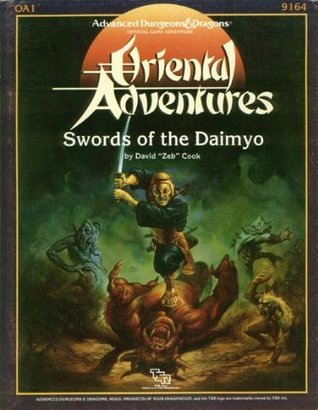In my A Game Per Year project, my goal has been to read one roleplaying game corebook for every year they’ve been published. However, I soon started to feel that it was hard to decipher how the games were really meant to be played. For this reason, I decided to start a parallel project, An Adventure Per Year, to read one roleplaying adventure for each year they’ve been published.

Swords of the Daimyo is the first adventure released for the AD&D Oriental Adventures setting. It’s interesting because it feels like it’s been published at a time of flux, when the design standards and setting specifics were changing. At the time of its release, the Oriental Adventures continent of Kara-Tur was its own world but later it was incorporated into the Forgotten Realms.
Kara-Tur is a fantasy approximation of Asia created by 1980’s American game designers. Shou-Lung is fake China and Kozakura, the setting of this adventure, is fake Japan. Indeed, pretty much the entire line of Oriental Adventures scenarios was set in Kozakura.
As an adventure, Swords of the Daimyo is a weird grab-bag of stuff. To start with, there’s no daimyo nor any specific swords. Instead, there are three short adventures introducing characters to the setting. In the first, the players’ existing ordinary Western-style fantasy characters can take a ship and sail to Kozakura. The adventure proposes an interesting method for converting the party into local Kozakuran characters: They die one by one and newly created characters are made using the options from the book Oriental Adventures.
The second adventure features a village under attack and in the third the characters follow the attackers to their camp and kill them. Very basic stuff.
The rest of the release is composed of maps and a setting guide to Kozakura. It shows the fading legacy of the hexcrawl style of design where outdoors spaces are also primarily physical environments for the characters to explore, the same as dungeons. The characters move and map wilderness hex by hex on the map and the book describes notable landmarks, towns and other features, organized by hex number.
The setting material goes into extraordinary detail on the specifics of Kozakuran governmental organization. We learn of the balance of power between the Emperor, the Emperor’s grandfather, the Shogun and many other important figures.